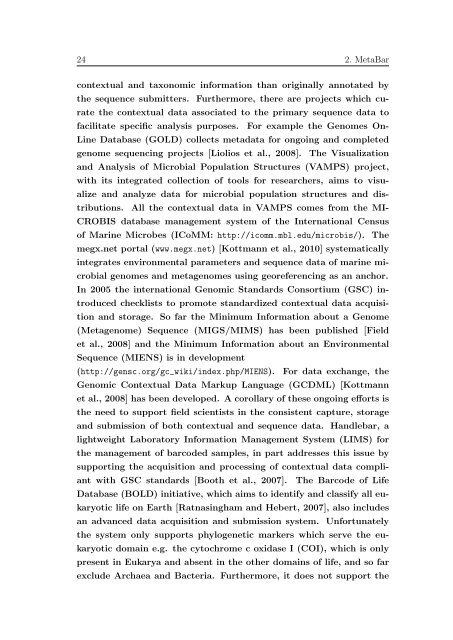Data integration in microbial genomics ... - Jacobs University
Data integration in microbial genomics ... - Jacobs University
Data integration in microbial genomics ... - Jacobs University
You also want an ePaper? Increase the reach of your titles
YUMPU automatically turns print PDFs into web optimized ePapers that Google loves.
24 2. MetaBar<br />
contextual and taxonomic <strong>in</strong>formation than orig<strong>in</strong>ally annotated by<br />
the sequence submitters. Furthermore, there are projects which curate<br />
the contextual data associated to the primary sequence data to<br />
facilitate specific analysis purposes. For example the Genomes On-<br />
L<strong>in</strong>e <strong>Data</strong>base (GOLD) collects metadata for ongo<strong>in</strong>g and completed<br />
genome sequenc<strong>in</strong>g projects [Liolios et al., 2008]. The Visualization<br />
and Analysis of Microbial Population Structures (VAMPS) project,<br />
with its <strong>in</strong>tegrated collection of tools for researchers, aims to visualize<br />
and analyze data for <strong>microbial</strong> population structures and distributions.<br />
All the contextual data <strong>in</strong> VAMPS comes from the MI-<br />
CROBIS database management system of the International Census<br />
of Mar<strong>in</strong>e Microbes (ICoMM: http://icomm.mbl.edu/microbis/). The<br />
megx.net portal (www.megx.net) [Kottmann et al., 2010] systematically<br />
<strong>in</strong>tegrates environmental parameters and sequence data of mar<strong>in</strong>e <strong>microbial</strong><br />
genomes and metagenomes us<strong>in</strong>g georeferenc<strong>in</strong>g as an anchor.<br />
In 2005 the <strong>in</strong>ternational Genomic Standards Consortium (GSC) <strong>in</strong>troduced<br />
checklists to promote standardized contextual data acquisition<br />
and storage. So far the M<strong>in</strong>imum Information about a Genome<br />
(Metagenome) Sequence (MIGS/MIMS) has been published [Field<br />
et al., 2008] and the M<strong>in</strong>imum Information about an Environmental<br />
Sequence (MIENS) is <strong>in</strong> development<br />
(http://gensc.org/gc_wiki/<strong>in</strong>dex.php/MIENS). For data exchange, the<br />
Genomic Contextual <strong>Data</strong> Markup Language (GCDML) [Kottmann<br />
et al., 2008] has been developed. A corollary of these ongo<strong>in</strong>g efforts is<br />
the need to support field scientists <strong>in</strong> the consistent capture, storage<br />
and submission of both contextual and sequence data. Handlebar, a<br />
lightweight Laboratory Information Management System (LIMS) for<br />
the management of barcoded samples, <strong>in</strong> part addresses this issue by<br />
support<strong>in</strong>g the acquisition and process<strong>in</strong>g of contextual data compliant<br />
with GSC standards [Booth et al., 2007]. The Barcode of Life<br />
<strong>Data</strong>base (BOLD) <strong>in</strong>itiative, which aims to identify and classify all eukaryotic<br />
life on Earth [Ratnas<strong>in</strong>gham and Hebert, 2007], also <strong>in</strong>cludes<br />
an advanced data acquisition and submission system. Unfortunately<br />
the system only supports phylogenetic markers which serve the eukaryotic<br />
doma<strong>in</strong> e.g. the cytochrome c oxidase I (COI), which is only<br />
present <strong>in</strong> Eukarya and absent <strong>in</strong> the other doma<strong>in</strong>s of life, and so far<br />
exclude Archaea and Bacteria. Furthermore, it does not support the

















